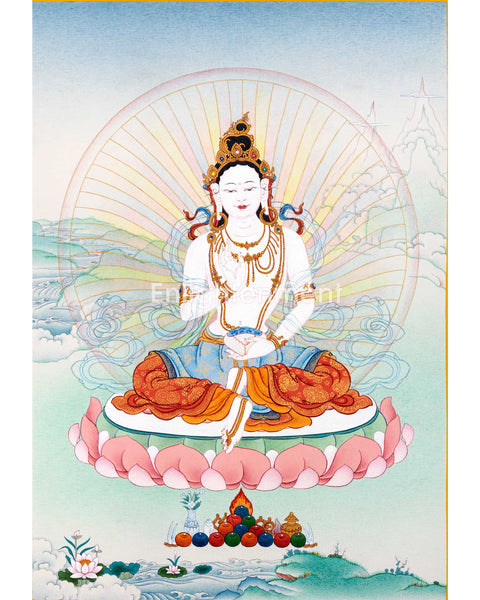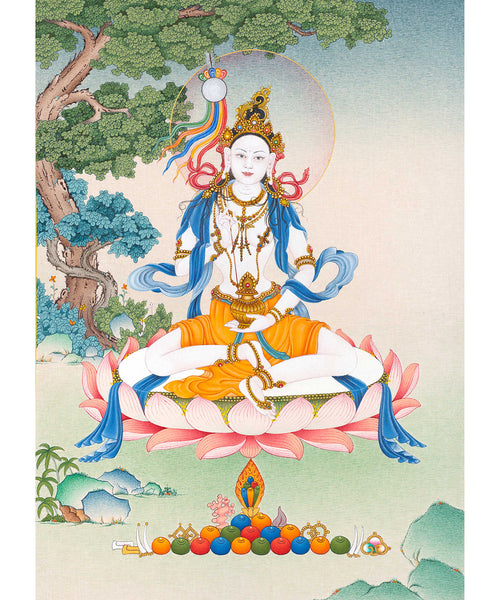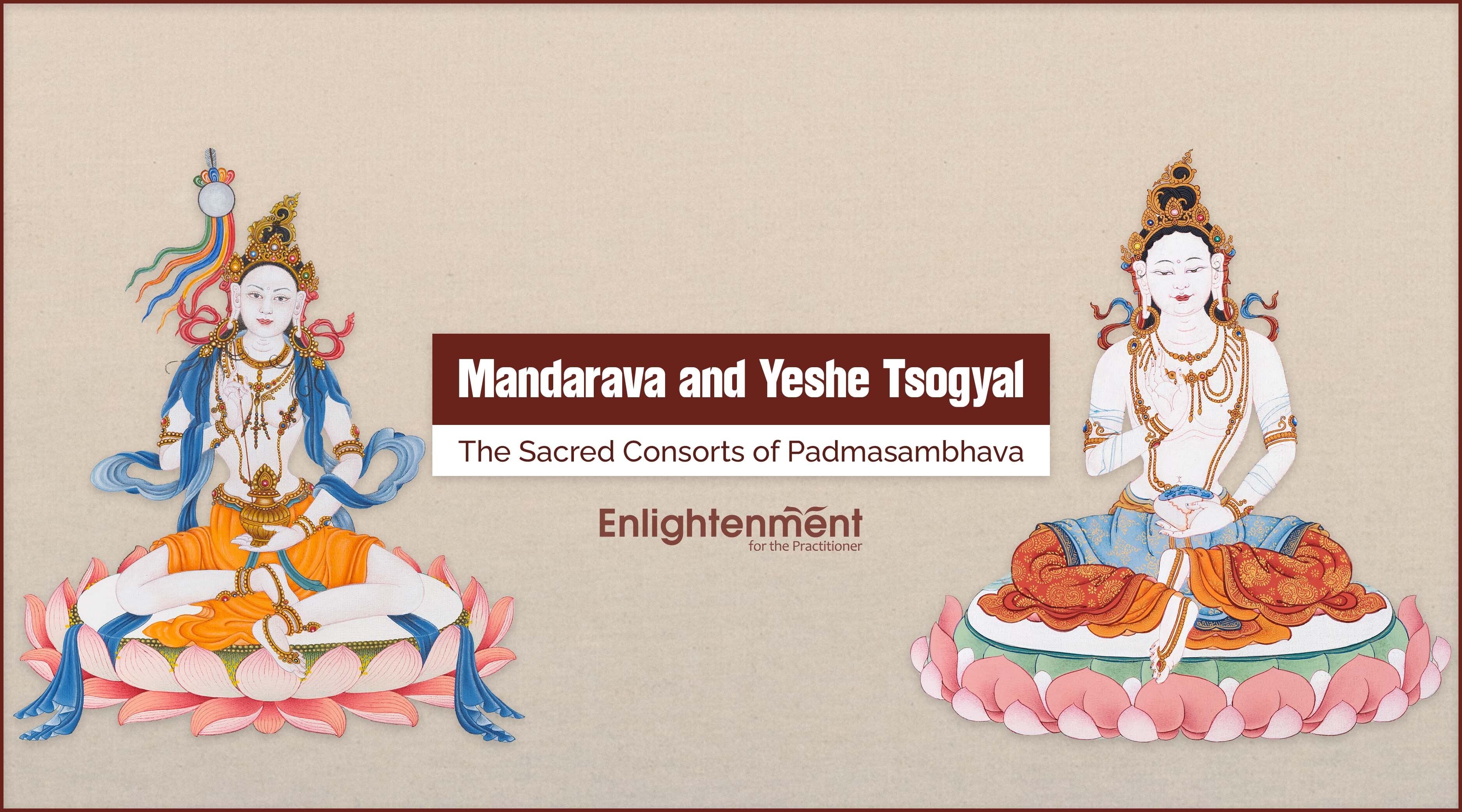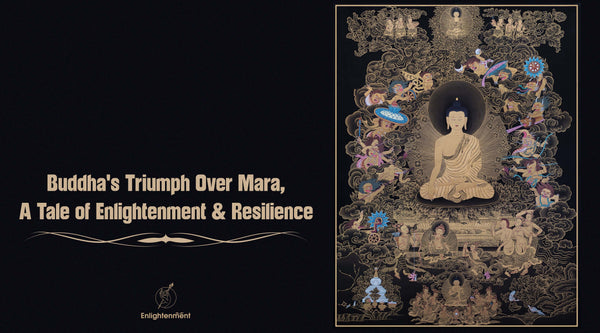Yeshe Tsogyal and Mandarava: The Sacred Consorts of Padmasambhava
Within the intricate tapestry of Tibetan Buddhism, Yeshe Tsogyal and Mandarava shine as extraordinary women who played vital roles in advancing the Vajrayana tradition. They are best known as the sacred companions of Guru Padmasambhava, an immensely revered figure within Tibetan Buddhism.
The union of Yeshe Tsogyal and Mandarava with Padmasambhava underscores their spiritual prowess and Tibetan Buddhism's progressive recognition of women's significance in the spiritual path. Their celebrated lives and contributions encompass profound teachings, enlightened actions, and the embodiment of wisdom and compassion in perfect union.
Key Takeaways
- Yeshe Tsogyal and Mandarava served as Guru Padmasambhava's sacred consorts, signifying their crucial roles in Tibetan Buddhism.
- Their partnership exemplifies the inclusive and progressive stance of Tibetan Buddhism toward women.
- Yeshe Tsogyal's life and teachings have left an enduring imprint on Tibetan Buddhism, serving as a perennial source of inspiration for contemporary practitioners.
- Mandarava is revered for her unwavering devotion and profound realizations, earning her a special place in the annals of Tibetan Buddhism.
Guru Padmasambhava: The Lotus-Born Guru

Click here to view our Guru Rinpoche With His Consorts Thangka Print
To truly appreciate the significance of Yeshe Tsogyal and Mandarava, it's crucial first to understand Padmasambhava's role in Tibetan Buddhism. Often known as Guru Rinpoche, Padmasambhava holds a central position in Vajrayana Buddhism. Born miraculously from a lotus in the 8th century, he was pivotal in introducing Buddhism to Tibet. Revered as the second Buddha, Guru Rinpoche is credited with subduing opposing forces and establishing the Dharma in the Himalayan region. Exceptional spiritual achievements and a profound repository of teachings define his legacy.
The Importance of Consorts in Vajrayana Buddhism
In Vajrayana Buddhism, spiritual consortship is integral to unlocking a practitioner's inherent wisdom and compassion. A consort, often known as a yogini or dakini, is a valuable companion, aiding the practitioner on their spiritual path. Yeshe Tsogyal and Mandarava, among the most celebrated consorts linked with Padmasambhava, exemplify the profound transformative potential of this sacred partnership.
Dakini Yeshe Tsogyal: The Queen of Dharma

Early Life and Connection with Padmasambhava
Yeshe Tsogyal, meaning "Victorious Ocean of Wisdom," was born in 8th-century Tibet. Destined to play a crucial role in the propagation of Buddhism in Tibet, she became the consort of Padmasambhava. Her life is a rich narrative of devotion, learning, and spiritual awakening. Remarkably, at a young age, Guru Rinpoche identified her as the reincarnation of the renowned princess Mandarava.
The Dakini's Accomplishments
Yeshe Tsogyal's spiritual odyssey was undeniably extraordinary. She supported Padmasambhava in his teachings and emerged as a revered teacher in her regard. Her accomplishments include:
- Compilation of Terma Texts: She is celebrated for concealing and subsequently unveiling terma texts, a treasure trove of teachings, for the benefit of future generations.
- Establishing Nunneries: She was pivotal in founding nunneries, providing dedicated spaces for women to engage in rigorous practice and study.
- Teaching and Transmission: Yeshe Tsogyal transmitted the profound teachings of Vajrayana Buddhism to her disciples, guaranteeing the tradition's perpetuation.
- Enlightenment and Liberation: Her profound spiritual realization exemplified the transformative potential of Vajrayana practice.
- Founding Monasteries and Retreat Centers: Yeshe Tsogyal established numerous monasteries and retreat centers, securing the continued flourishing of the Dharma.
Legacy and Recognition
Yeshe Tsogyal's profound spiritual achievements and contributions have led to her acknowledgment as a female Buddha within Tibetan Buddhism. Her enduring legacy lives on through her teachings, writings, and the countless practitioners she continues to inspire.
Her life is an inspirational example for practitioners, underscoring the importance of devotion, unwavering dedication, and the transformative potential of the spiritual journey. Her legacy thrives through the teachings and practices associated with her name.
Mandarava: The Devoted Dakini, Princess of Zahor
Click here to view our Mandarava Thangka Painting
While Yeshe Tsogyal's remarkable journey is extensively documented, Mandarava's story is equally inspiring. Mandarava, also known as Princess Mandarava of Zahor, came into the world in the 8th century. Her life took a momentous turn when she crossed paths with Padmasambhava. Guru Rinpoche identified her as an emanation of the wisdom dakini Vajravarahi, destined to play a pivotal role in his mission to propagate the Dharma in Tibet.
Mandarava's Spiritual Journey
Mandarava's spiritual odyssey was characterized by steadfast devotion and dedicated practice. She embarked on rigorous meditation retreats and received profound teachings from Padmasambhava, culminating in realizing the ultimate truth. Her deep comprehension of the Vajrayana path and her wisdom were vital in aiding Guru Rinpoche in his mission.
Meeting Padmasambhava
Mandarava's union with Padmasambhava epitomized the connection between guru and consort in Vajrayana Buddhism. Together, they embodied enlightened wisdom and compassion, becoming a living source of inspiration for numerous practitioners.
The Power of Devotion
Mandarava's defining quality lay in her unwavering devotion to Padmasambhava, as evidenced by her readiness to endure significant hardships and challenges on her spiritual journey.
Her spiritual odyssey reached its zenith with profound realization, and she, in turn, became a teacher, imparting wisdom to her disciples while underscoring the significance of devotion, meditation, and the journey toward enlightenment.
Her legacy persists through the teachings and practices linked to her name, where she stands as a revered symbol of feminine wisdom and empowerment within the Vajrayana tradition.
The Significance of Yeshe Tsogyal and Mandarava
The narratives of Yeshe Tsogyal and Mandarava transcend mere historical accounts; they carry profound significance in Tibetan Buddhism.
-
Breaking Gender Stereotypes
The partnership of Yeshe Tsogyal and Mandarava with Guru Padmasambhava defies conventional gender roles and stereotypes. Their prominent positions as spiritual leaders and educators underscore the inclusive and progressive ethos of Vajrayana Buddhism. -
Spiritual Attainments
Both Yeshe Tsogyal and Mandarava achieved profound spiritual realization, underscoring the irrelevance of gender on the path to enlightenment. Their teachings and practices remain a guiding light for practitioners on the journey to profound awakening. -
The Union of Wisdom and Compassion
Yeshe Tsogyal and Mandarava are esteemed not only for their achievements but also for their representation of the union of wisdom and compassion. In Vajrayana Buddhism, this union is integral to recognizing one's authentic nature and achieving enlightenment. The sacred companionship of Yeshe Tsogyal and Mandarava with Padmasambhava symbolizes the balance and fusion of these crucial facets of the spiritual journey.
The Profound Teachings of Yeshe Tsogyal & Mandarava
Yeshe Tsogyal left behind a rich legacy of teachings that continue to guide and inspire practitioners:
- Dzogchen Teachings: She transmitted the profound Dzogchen teachings, emphasizing the direct recognition of one's true nature.
- Liberation through Hearing: Yeshe Tsogyal's "Liberation through Hearing" is a collection of her revelations and teachings, providing profound insights into the path of liberation.
Mandarava's teachings emphasize the importance of devotion and practice:
- Devotion to Guru: She highlighted the significance of unwavering devotion to one's guru to unlock the lineage's blessings and wisdom.
- Tantric Practices: Mandarava's teachings include profound tantric practices that lead practitioners towards spiritual realization.
The Relevance of Yeshe Tsogyal and Mandarava Today
- Empowerment of Women in Buddhism
The lives of Yeshe Tsogyal and Mandarava defy conventional gender roles and stereotypes in Buddhism. Their eminence as spiritual leaders, instructors, and yoginis highlights the significance of acknowledging and empowering women within the Buddhist community. Today, their narratives serve as an inspiration for ongoing endeavors to offer equal opportunities to women in the quest for spiritual realization.
- Preservation of Vajrayana Traditions
Yeshe Tsogyal and Mandarava played pivotal roles in safeguarding and transmitting the esoteric teachings and practices of Vajrayana Buddhism. In a world where ancient wisdom often faces the risk of fading away, their contributions are a poignant reminder of the imperative to preserve and hand down traditional teachings for future generations. Inner Realization and Partnership
The sacred companionship of Yeshe Tsogyal and Mandarava with Padmasambhava underscores the transformative influence of inner realization and partnership on the spiritual journey. Their example inspires practitioners to nurture wisdom and compassion, recognizing the profound potential that arises from the synergy of these qualities.
To sum it up, Yeshe Tsogyal and Mandarava, in their roles as the sacred consorts of Guru Padmasambhava, epitomize the essence of Vajrayana Buddhism—a path characterized by transformation, realization, and transcendence. Their lives and teachings continue to serve as a wellspring of inspiration and empowerment for practitioners, reminding us that wisdom and devotion are the genuine markers of spiritual greatness.
With deep reverence, we contemplate the lives and legacies of these two extraordinary women whose journey alongside Padmasambhava illuminated the path for future generations.


